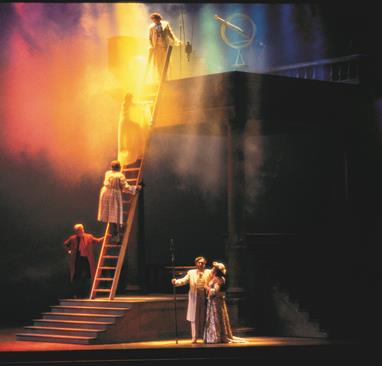Back Stories III
Throughout its 50th anniversary year, OPERA America is saluting its 16 founding member companies. Here’s a look at three of them, then and now.
Opera Saratoga
In 1962, baritone Fred Patrick and his wife, soprano Jeanette Scovotti, founded Lake George Opera. Originally operating in Lake George itself, an Upstate New York resort community nestled in the Adirondacks, the company moved 10 miles south in 1965 to the town of Glen Falls. After Patrick’s untimely death in 1965, David Lloyd took the reins as general director, presenting a repertory that included a significant number of world premieres and recent American operas — an emphasis that continues to this day.
The company pulled up stakes once again in 1998, when renovations to its auditorium in Glen Falls necessitated a relocation another 10 miles south to the Spa Little Theatre, on the grounds of the Saratoga Performing Arts Center. The move proved permanent: The 500-seat auditorium proved a wonderful, intimate venue for the company’s brand of opera, and in 2011 the company changed its name to Opera Saratoga.
Lawrence Edelson became general and artistic director in 2014. Under his aegis, Opera Saratoga has continued its tradition of presenting new and unusual repertoire, including the world premiere of Ricky Ian Gordon and Frank Bidart’s Ellen West and a rare production of Marc Blitzstein’s seminal musical-theater work The Cradle Will Rock.


Cincinnati Opera
The 1920 founding of the Cincinnati Opera Association makes it the second-oldest opera company in the U.S. But even then, the city, with its large German population, had long been a mecca for classical music. Even before the founding of the Cincinnati Opera Association, the city had a vigorous operatic tradition, hosting a number of touring opera companies in the 19th and early 20th centuries, including the Metropolitan Opera from 1901 to 1911. For its first half-century, the company resided at the Cincinnati Zoo — a circumstance that gave rise to much operatic lore, like the time parrots from a nearby cage joined their voices to the Flower Duet from Madama Butterfly.
In 1972, Cincinnati Opera moved from the zoo to its present home, the 3,417-seat Music Hall. Evans Mirageas was appointed artistic director in 2005. During his tenure, the company has launched the Opera Campus program, bringing performances to venues throughout the city. In 2016, it presented the world premiere of Gregory Spears and Greg Pierce’s Fellow Travelers, and in 2017 launched CO Next: Diverse Voices, offering works that feature the stories of underrepresented populations, starting with Missy Mazzoli and Royce Vavrek’s Songs from the Uproar.


Seattle Opera
Forged out of the determination and energy of Glynn Ross, its founding general director, Seattle Opera was launched in 1963 and quickly gained a profile as an operatic powerhouse in the Pacific Northwest. In 1970, the company mounted the world premiere of Carlisle Floyd’s Of Mice and Men. That occasion marked a significant milestone: the founding of OPERA America, spearheaded by Ross.
The summer of 1975 marked Seattle Opera’s first two cycles of Wagner’s Ring, one in German and one in English, starting a tradition that continued uninterrupted for the next eight seasons and established the company as a mecca for Wagnerians worldwide. Speight Jenkins, who took over as general director in 1983, mounted two further new Ring productions during his tenure, as well as much unusual repertoire and the company’s first commission, Daron Hagen and Gardner McFall’s Amelia, in 2010. Under the leadership of Aidan Lang, general director from 2014 to 2019, Seattle Opera presented the world premiere of Jack Perla and Jessica Murphy Moo’s An American Dream.
The company moved its performances into Marion Oliver McCaw Hall in 2003, and in 2017, opened its new Opera Center: a glass-enclosed facility that not only holds administration offices, rehearsal studios and a performance space, but also positions Seattle Opera as a vital community resource.


This article was published in the Spring 2020 issue of Opera America Magazine.




